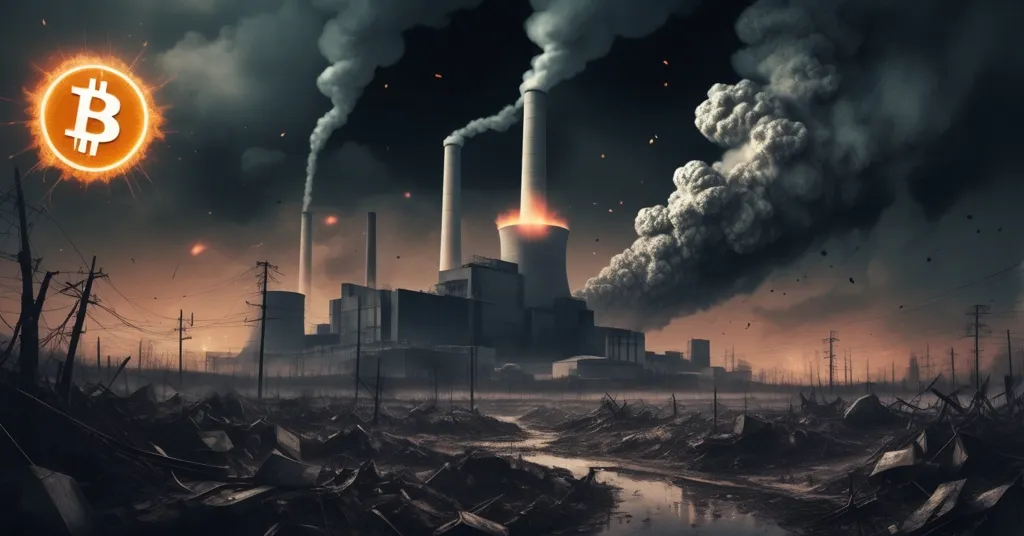Russia-Ukraine War Escalates: Nuclear Risks and Bitcoin’s Decentralized Potential

Russia Shuts Down Putin-Zelensky Talks as War Targets Nuclear and Energy Lifelines
Russia has flatly rejected the idea of peace talks between President Vladimir Putin and Ukrainian President Volodymyr Zelensky, brushing off U.S. President Donald Trump’s diplomatic overtures as violence escalates. With missile strikes and drone attacks hitting nuclear power plants and critical oil pipelines, the chaos exposes the fragility of centralized systems—begging the question, could Bitcoin and blockchain technology offer a decentralized lifeline in such turbulent times?
- No Peace in Sight: Russia states no agenda exists for a Putin-Zelensky summit, dismissing Trump’s mediation.
- War Intensifies: Russian missiles pound Ukraine, while Ukrainian drones strike a Russian nuclear plant and key oil infrastructure.
- Energy Fallout: Oil supply cuts to Hungary and Slovakia reveal Europe’s vulnerable energy dependence, ripe for decentralized solutions.
Battlefield Escalation: From Missiles to Nuclear Gambles
The Russia-Ukraine conflict, ignited by the 2014 annexation of Crimea and exploding into full-scale war in 2022, is far from cooling down. Russia has intensified its missile barrage on Ukrainian targets, including an electronics plant tied to a U.S. company, a clear jab at Western interests. Not to be outdone, Ukraine marked its 34th Independence Day with a fierce counterattack, deploying drones deep into Russian territory. One audacious strike targeted the Kursk Nuclear Power Plant, just 60 kilometers from the border, slashing reactor capacity by 50%. The International Atomic Energy Agency (IAEA), a global watchdog for nuclear safety, confirmed radiation levels stayed normal, dodging an immediate disaster. Still, the attack’s boldness has sparked outrage, with Kursk’s acting governor, Alexander Khinshtein, slamming it as a violation of international norms.
“The plant is just 60 kilometers from the border and [the drone strikes are] a breach of all international conventions.” – Alexander Khinshtein, Acting Governor of Kursk
Let’s be brutally clear: targeting a nuclear facility in an active warzone is playing with fire. One misstep, one failed safety protocol, and we’re staring down a Chernobyl-style catastrophe. The IAEA’s reassurance of stable radiation levels is a thin comfort when conflict rages so close to such volatile infrastructure. Under international laws like the Geneva Conventions, critical facilities like nuclear plants are supposed to be off-limits, but war doesn’t play by the rules. This isn’t just a regional problem—it’s a global one, a stark reminder of how centralized points of failure can threaten us all.
Energy Under Siege: Centralized Systems Crumble
Beyond nuclear risks, Ukraine’s drone strategy hit another critical target: the Unecha pumping station on the Druzhba oil pipeline in Bryansk. For context, the Druzhba pipeline, a Soviet-era relic, channels crude oil from Russia to Eastern Europe, acting as a lifeline for nations like Hungary and Slovakia. This attack has halted deliveries, with disruptions potentially lasting five days or longer. Hungary, which depends on this pipeline for over half its crude oil, and Slovakia are reeling from the blow. Their foreign ministers, Péter Szijjártó and Juraj Blanár, didn’t hold back, calling the strike a direct assault on their energy security in a joint letter to the European Commission.
“Another attack on the energy security of our country. Another attempt to drag us into war.” – Péter Szijjártó, Hungarian Foreign Minister
The numbers paint a grim picture. Hungary and Slovakia rely on this pipeline for a massive chunk of their energy needs, and alternative sources aren’t easily accessible due to geographical and political constraints. Hungarian Prime Minister Viktor Orbán, who’s taken a notably neutral stance by refusing military or economic aid to Ukraine and even met Putin directly last year, now faces a test of that neutrality as his country’s energy stability hangs in the balance. This isn’t just a war story—it’s a case study in the catastrophic flaws of centralized infrastructure. When a single pipeline’s disruption can kneecap entire economies, the system is begging to be rethought, as seen in the broader impact on energy infrastructure during this conflict.
Diplomatic Deadlock: Talks Go Nowhere Fast
Against this backdrop of destruction, hopes for peace seem laughably distant. Russian Foreign Minister Sergey Lavrov has made it crystal clear: there’s no groundwork for a summit between Putin and Zelensky. This pours ice on Trump’s so-called “energetic diplomacy,” which included a meeting with Putin in Alaska and hosting Zelensky with European leaders at the White House, as detailed in recent updates on Trump’s mediation efforts. U.S. Vice President JD Vance admitted the harsh reality, noting they might hit a “brick wall” if diplomacy fails to gain traction. Frankly, it looks like both sides are more interested in lobbing missiles than shaking hands.
“Putin is ready to meet with Zelensky, when the agenda would be ready for a summit. And this agenda is not ready at all.” – Sergey Lavrov, Russian Foreign Minister
Peel back the curtain, and the diplomatic game gets uglier. Analysts like Andrew S. Weiss from the Carnegie Endowment argue Zelensky’s public push for a meeting is a calculated move to paint Putin as the roadblock, while Putin likely views any summit as a stage for Ukraine’s capitulation, not compromise. Post-war security ideas, like a “reassurance force” of 15,000 Western troops to deter future aggression, are floating around, but experts like Eric Ciaramella call them hollow without serious U.S. military commitment. Russia, meanwhile, would likely demand legal recognition of its control over Crimea and Donbas—terms Ukraine won’t touch. Trump’s initial ceasefire pitch reportedly shifted after talks with Putin to prioritize a peace treaty, effectively giving Russia leeway to keep hammering away. It’s a diplomatic charade with no winners, just more rubble, as reported in Russia’s dismissal of a Putin-Zelensky meeting.
Decentralization in Crisis: Bitcoin and Blockchain Step Up
Now let’s talk about why this matters to us in the crypto space. Geopolitical meltdowns like this don’t just tank traditional markets—they send shockwaves that make decentralized systems like Bitcoin look like a damn good idea. Bitcoin, a digital currency free from government control, often surges in interest during crises as a hedge against fiat currency devaluation or banking collapse. Back in 2022, when Russia’s invasion kicked off, Ukraine became a real-world test case. Ukrainians used Bitcoin to move funds or receive aid when traditional systems crumbled, with over $225 million in crypto donations pouring in since the war began, according to Chainalysis reports. This role of Bitcoin as a crisis currency in the Russia-Ukraine war is raw proof that decentralization can be a financial escape hatch in the worst of times.
But let’s not get carried away with rose-tinted glasses. Bitcoin isn’t a magic fix. Its price swings can screw over anyone trying to use it as a stable store of value in a warzone, and good luck finding merchants accepting it when bombs are dropping. Still, the principle stands—centralized finance fails under pressure, and Bitcoin offers an alternative, however imperfect, as discussed in various community insights on Bitcoin’s use in the Ukraine conflict. On the energy front, the Druzhba pipeline mess screams for decentralized solutions. Blockchain platforms like Power Ledger enable peer-to-peer energy trading, letting communities bypass fragile centralized grids through tokenized energy credits and smart contracts. Imagine Hungarian or Slovakian towns trading surplus solar power directly, no pipeline needed, an idea explored in concepts of decentralized energy solutions for conflict zones. Sure, adoption barriers and infrastructure costs are real hurdles, especially in conflict zones, but the idea aligns with our push for effective accelerationism—fast-tracking systemic change through tech.
Beyond wealth protection and energy, blockchain’s potential shines in humanitarian aid. With millions displaced and cities leveled, aid distribution often gets mired in corruption or inefficiency. Blockchain could ensure transparency, tracking every dollar (or satoshi) from donor to recipient, a concept elaborated in discussions on how blockchain aids war crises. Ukraine’s government even set up official crypto wallets for donations post-2022, a nod to decentralization’s practical edge. A word of caution, though: war breeds scams. Fake donation wallets spiked during the conflict’s early days, preying on goodwill. Stick to verified sources if you’re contributing. This isn’t just about tech—it’s about the ethos of freedom and privacy we champion, proving its worth when centralized systems turn to ash.
Key Takeaways and Burning Questions
- What’s the latest on Russia-Ukraine peace talks?
Nothing’s happening. Russia claims no agenda is set for a Putin-Zelensky meeting, and despite Trump’s efforts, military action overshadows any dialogue. - How are energy disruptions from this war hitting Europe?
Ukraine’s strike on the Druzhba pipeline cut oil to Hungary and Slovakia, exposing Europe’s reliance on centralized energy infrastructure and risking economic strain. - Why are nuclear plant attacks so alarming?
Hits on facilities like Kursk risk catastrophic fallout if safety fails, violating international protections and raising global stakes beyond the battlefield. - How does the Russia-Ukraine war impact Bitcoin and crypto?
Geopolitical chaos often boosts Bitcoin interest as a non-sovereign asset, with Ukraine’s $225 million in crypto aid since 2022 showing its role in crisis finance. - Can blockchain address energy crises exposed by this conflict?
Platforms like Power Ledger suggest decentralized energy trading as an alternative to brittle grids, though adoption challenges remain significant in war-torn areas. - Is Trump’s diplomacy gaining any ground?
Hardly. Escalation on both sides shows limited U.S. influence, with Putin and Zelensky entrenched in their positions despite mediation attempts. - What can the crypto community learn from these centralized failures?
War highlights the fragility of traditional systems—finance, energy, aid—reinforcing the urgent need for decentralized tech to build resilience and autonomy.
So here we stand, watching a war that’s not just about borders but about the utter breakdown of centralized trust—whether it’s energy grids, diplomatic frameworks, or financial safety nets. Ukraine’s drone strikes mirror the kind of asymmetric disruption we celebrate in the crypto world, like Bitcoin flipping the bird at traditional banking. But let’s not kid ourselves: this conflict is a human tragedy, displacing millions and teetering on nuclear disaster. For our community, the takeaway is sharp and undeniable. Crises like these validate why decentralization isn’t just a buzzword—it’s a necessity. Whether it’s safeguarding wealth with Bitcoin, envisioning blockchain-powered energy grids, or ensuring transparent aid, the principles we fight for are battle-tested in the harshest conditions. The flames of war burn on, but they light up the path to a freer, more resilient future.



